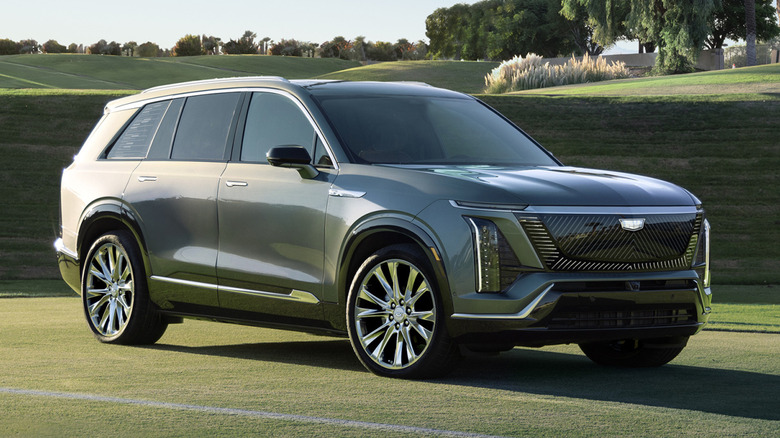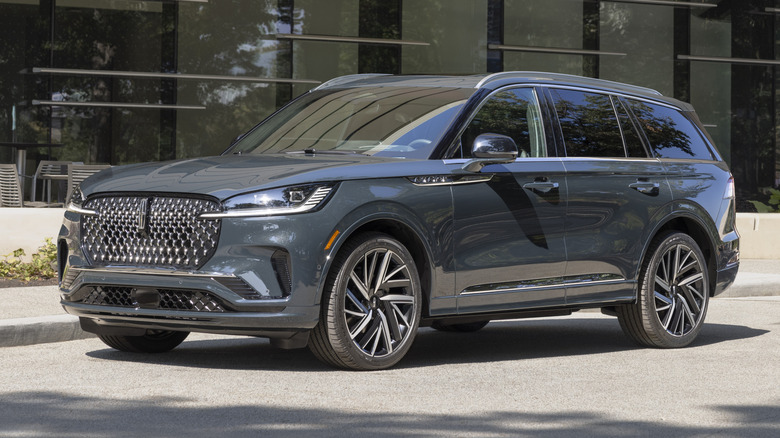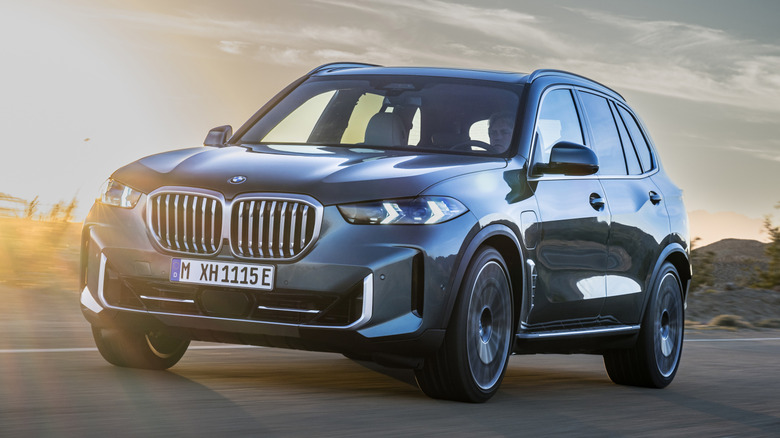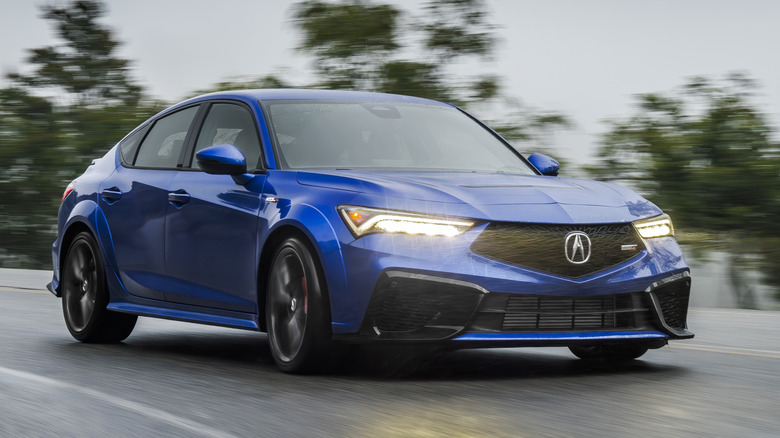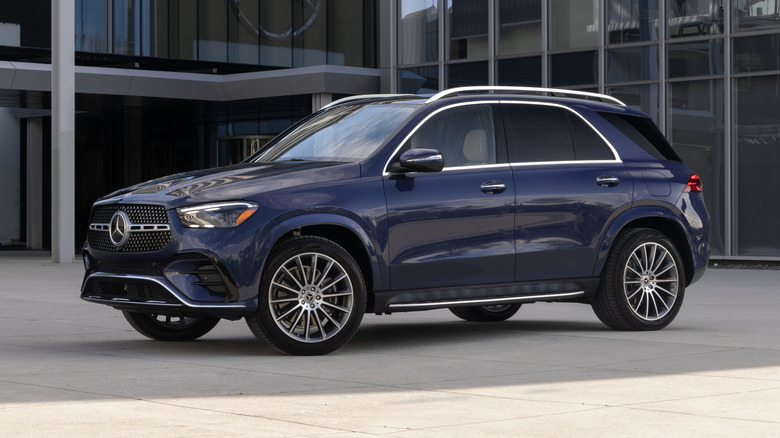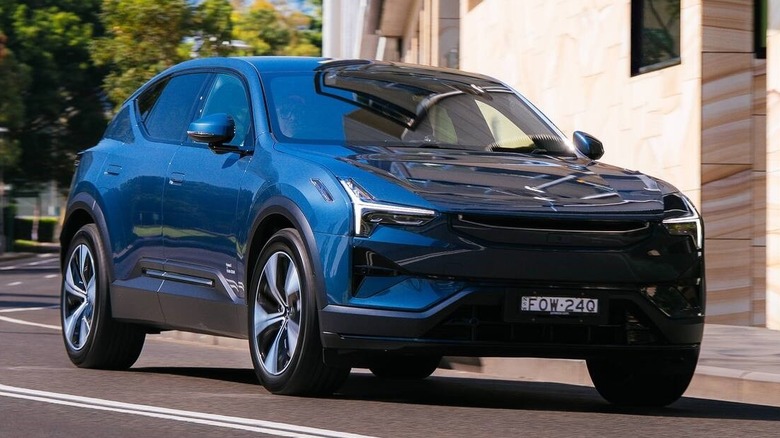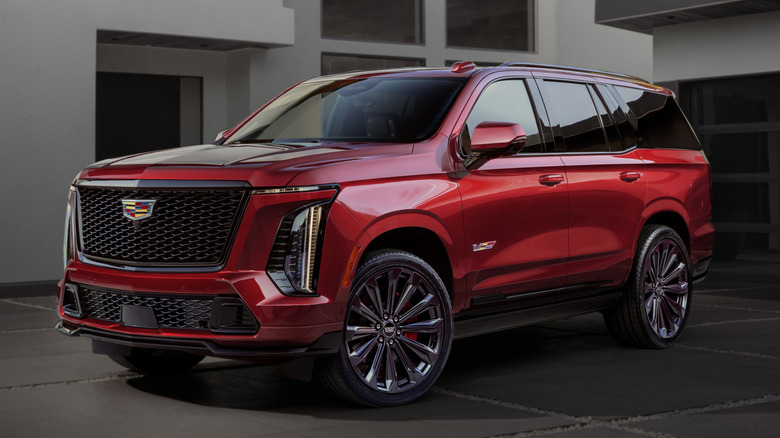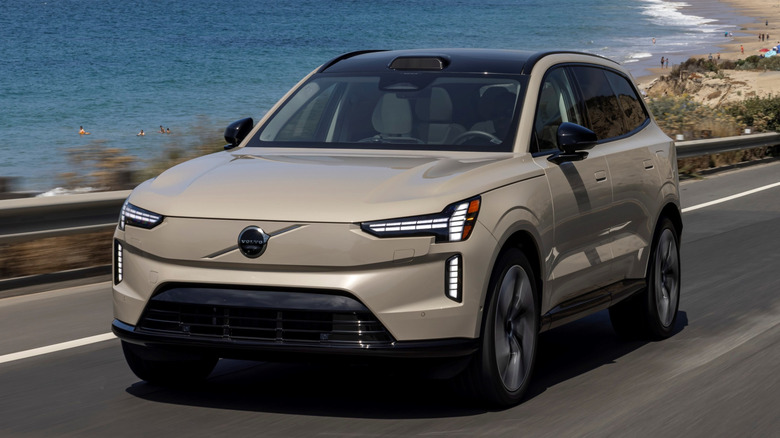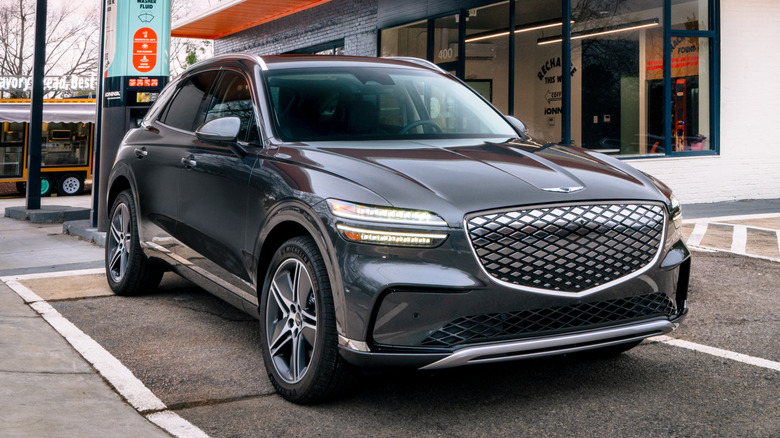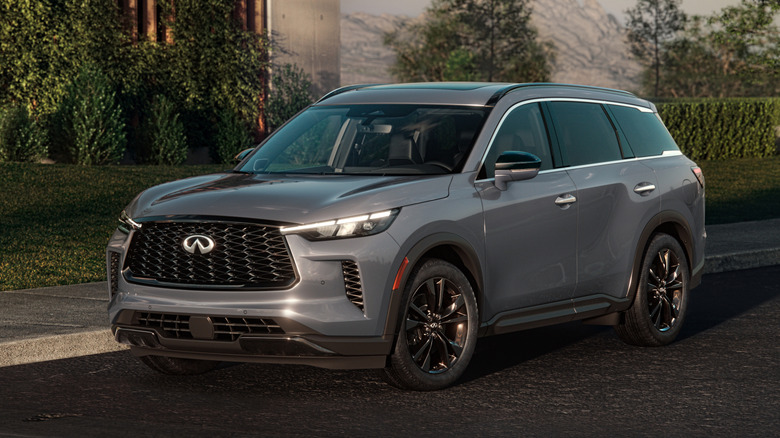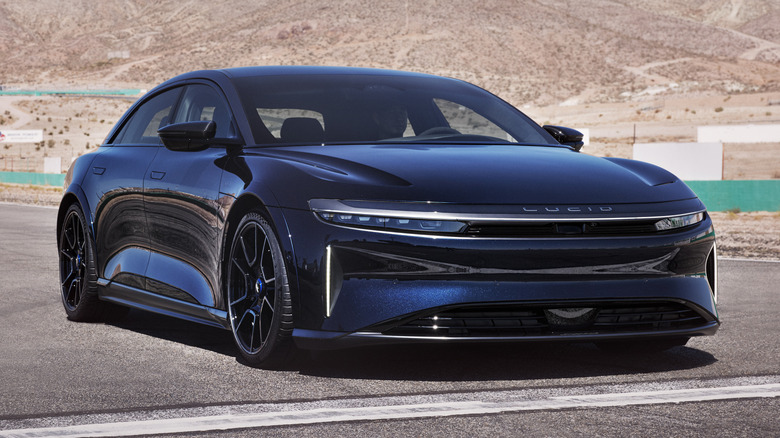11 Luxury Car Brands That Are Manufactured In America
Carmakers and buyers alike are scrambling to assess the impact of the current U.S. government's tariff plans, which have seen sizable levies placed on many of the country's key trading partners. The automotive industry is among those most affected by the tariffs, with every segment from economy-focused cars to ultra-luxury vehicles being subject to the new rules. It is easy to assume that foreign automakers will be more affected than domestic brands, but that is not necessarily the case.
In reality, many American brands build one or more of their car models outside of the U.S., and many foreign brands have extensive manufacturing networks within the country. While U.S.-built cars might still potentially be affected by tariffs if components or raw materials are brought in from abroad, they're generally protected from the worst effects of the new tariff system.
Whether you're looking to buy an American-made car to support domestic industry or simply trying to see which automakers are least likely to enact tariff-related price hikes, it is worth knowing which automakers actually manufacture their cars in the United States. These 11 luxury car brands all make one or more models domestically, although nearly all of them still make some of the models in their lineup outside the country.
Lincoln
Despite its all-American heritage, Lincoln Motor Company's cars are built both inside and outside the U.S. The Aviator is built in Ford's Chicago Assembly Plant, and will reportedly continue to be built there until at least the end of the decade. Ford previously mulled over the idea of discontinuing the gas-powered Aviator in favor of an all-electric replacement model, but with slowing demand for electric vehicles, it scrapped those plans in 2024. Instead, Ford reportedly plans to invest in hybrid powertrains to better reflect buyers' current tastes.
Alongside the Aviator, two of Lincoln's other models are built in America. The Corsair is manufactured in the Louisville Assembly Plant in Kentucky, while the Lincoln Navigator is made in the nearby Kentucky Truck Plant alongside the Ford Expedition and Super Duty trucks. However, the Nautilus is the outlier in the Lincoln line, since it's made in China. Despite the threat of high tariffs by the current government, Lincoln has previously clarified that it has no plans to bring the manufacturing of the Nautilus stateside, even if the tariffs mean that it has to increase prices for the model.
BMW
With manufacturing plants on five continents, BMW is a truly global automaker. The brand operates a large plant in the United States that is responsible for producing a wide variety of SUV models, including the X3, X4, X5, X6, X7, and XM. The plant is located in Spartanburg, South Carolina, and has reportedly built over 6.5 million cars since its launch more than three decades ago. Many of those cars are exported to other global markets as well as being sold within the United States.
Alongside its U.S. manufacturing operations, the brand also imports cars from its factories in Germany. The Dingolfing plant makes cars like the 4-Series, 7-Series, and iX, while the X1 and X2 crossovers are built in Regensburg. Outside of Germany, the brand also manufactures cars in several other European countries. Its latest factory is in Hungary, which is set to produce the brand's Neue Klasse vehicles starting in late 2025.
Acura
At the time of writing, Acura offers six models in its lineup: the Integra, ADX, TLX, RDX, ZDX, and MDX. Five out of six of those models are built in America, with one built south of the border in Mexico. The TLX and Integra are built at Honda's Marysville Auto Plant in Ohio, which also formerly built the Integra's predecessor, the ILX. The MDX and RDX are also built in Ohio, at the East Liberty Auto Plant.
The Acura ZDX isn't built by Honda, but rather by GM, at the latter's factory in Spring Hill, Tennessee. There's a good reason for that: the ZDX is built on GM's Ultium EV platform, and is related to the Cadillac Lyriq, which is built at the same plant. The ADX is the only current Acura model to be manufactured outside of the U.S., at Honda's Celaya plant in the state of Guanajuato, Mexico. It is built alongside the Honda HR-V. As a result, while Acura still has one model that might be subject to significant import tariffs, it is largely shielded from the worst effects of the government's ongoing trade war.
Mercedes-Benz
Rolling off the assembly lines at the Mercedes-Benz plant in Tuscaloosa, Alabama, are a variety of the German brand's models. Among them are the GLE and GLS luxury SUVs, alongside the all-electric EQE SUV and EQS SUV. The Maybach versions of both the GLS and EQS SUV are also produced at the same plant. Alabama forms just one part of a network of Mercedes-Benz assembly plants that spans several continents, with many of the brand's U.S. market models imported from Germany.
The Bremen plant is responsible for a significant proportion of those models, including the C-Class sedan, the EQE, the GLC, and the SL Roadster. The Mercedes-AMG GT sports car is also built at the plant. Another factory in Sindelfingen, Germany, builds the S-Class and EQS. The CLA and EQB, meanwhile, are manufactured elsewhere in Europe, at a facility in Kecskemét, Hungary. With its production facilities primarily stretched across Europe and America, Mercedes-Benz is highly vulnerable to the effects of any unilateral tariffs between the EU and the U.S. At the time of writing, negotiations regarding those tariffs remain ongoing.
Polestar
It might still be a relatively new brand in America, but Polestar's roots stretch back several decades in Europe. The brand was founded as an independent Swedish racing outfit and used Volvos to compete in touring car races across Europe. It also collaborated with Volvo on a handful of under-the-radar performance roadgoing models.
In 2010, Chinese automaker Geely bought a controlling stake in Volvo after Ford decided it no longer wanted the brand. It took an interest in Polestar and bought its road car division outright in 2015. Since then, the brand has rolled out a new range of upscale, performance-oriented EVs, with its largest model at the time of writing being the Polestar 3 SUV.
Through their shared parent company, Volvo and Polestar continue to be linked, although they're both standalone brands. The 3 is produced in Volvo's assembly plant in South Carolina, while its other two current models, the 2 and 4, are made in Asia. The 2 is made in the brand's facility in Chengdu, China, while the 2026 model year 4 is made in Busan, South Korea, at a facility that is reportedly shared with French carmaker Renault.
Cadillac
While most of Cadillac's current lineup is made in the U.S., not all of its cars can claim that title. The Escalade is made in GM's Arlington Assembly in Texas, while its electric counterpart, the Escalade IQ, is made in the automaker's dedicated EV facility in Detroit. Another Michigan facility, the Lansing Grand River Assembly & Stamping Plant, is responsible for producing the CT4 and CT5 sedans. Further south in Tennessee, the Spring Hill Manufacturing plant churns out four Cadillac models: XT5, XT6, Lyriq and Vistiq.
Cadillac's most luxurious model, the Celestiq, is built in a separate facility to other GM products. It's made in GM's Global Technical Center in Warren, Michigan, which also serves as the automaker's design and engineering headquarters. The Celestiq is the first production vehicle to be built at the facility since the campus initially opened in 1956.
While Cadillac still sells the XT4 as a 2025 model, production of the car ended in January 2025. It was formerly built at GM's facility in Fairfax, Kansas, which is now being retooled to produce the next generation Chevrolet Bolt. The Optiq is the brand's only current production model that's made outside of the U.S., and is assembled at the GM Ramos Arizpe plant in Mexico. It's built alongside Chevrolet's two electric crossovers, the Chevrolet Blazer EV and Equinox EV.
Lexus
Toyota's luxury arm makes many of its vehicles in its home country of Japan, but several Lexus models are also produced in North America. The ES sedan is made in Toyota's TMMK plant in Kentucky, while the recently introduced three-row TX SUV is made at TMMI in Indiana. Lexus also produces two of its most popular models, the RX and NX, at TMMC in Ontario, Canada. All of its other current models are produced at various plants in Japan.
Lexus has a little bit of flexibility regarding its production facilities, since it also makes the RX and NX in a plant in Kyushu, Japan, but it is still in a difficult situation with regards to tariffs. At the time of writing, Japan still faces significant tariffs as a favorable trade deal has yet to be worked out, while the U.S. government has threatened further tariffs on Canadian-made goods. Lexus enjoyed record global sales in 2024, in part thanks to the brand's increasing popularity in the U.S., but those sales figures are likely to drop in the future if the brand is forced to put its prices up to compensate for the impending tariffs.
Volvo
Swedish carmaker Volvo has a production facility in South Carolina which builds the S60 sedan and its new flagship electric model, the EX90. The rest of the brand's extensive lineup is currently built outside of the U.S., with its factories in three countries: Sweden, Belgium, and China. The Belgian plant builds hybrid and electric models like the all-electric EX30, hybrid XC40, and C40 Recharge. Volvo's best selling model, the XC60, is produced in both Sweden and China.
Its remaining models are split between China and Sweden, both of which are vulnerable to the effects of U.S. government tariffs. At the time of writing, a trade deal with China has reportedly been put into place, but the details remain unclear. Given the ongoing tensions between both countries, the terms of that deal may also change in the future. Sweden is a member of the EU, and so will be bound by any trade deal agreed between the bloc and the U.S. At the time of writing, no EU deal has been finalized.
Genesis
Another relative newcomer to the luxury car market, Genesis is the luxury marque of Korean automaker Hyundai. In early 2025, Hyundai opened a major new American manufacturing plant in Georgia, with plans to build various models for its Hyundai, Kia, and Genesis brands there. For now, exactly which models the brand intends to build in Georgia remains unclear. However, the brand already builds one model in America, the Electrified GV70. It's built at the HMMA plant in Alabama.
Aside from the Electrified GV70, Genesis builds all of its other models outside of America. All are built at Hyundai's huge manufacturing campus in Ulsan, Korea, which is the largest car factory in the world. It churns out 1.5 million cars every year, and consists of five plants producing 17 different models for the global market. A ship full of cars being exported leaves the nearby port every single day, making any lasting tariffs potentially very painful for Genesis and the Hyundai Group as a whole.
Infiniti
Although it is a Japanese brand, only one of Infiniti's 2025/6 models is made in Japan. That model is the QX80, which is built at Nissan's Shatai Kyushu Plant alongside a globe-spanning variety of Nissan models including the Middle Eastern market Patrol, the American market Armada, and the Japanese market Elgrand. Infiniti's other models are built in North America, with the QX60 being the only U.S. built model. It's assembled at the Nissan Smyrna Plant in Tennessee.
Infiniti's smaller crossover models, the QX50 and QX55, are built at the COMPAS Plant in Mexico. Both Nissan and Infiniti models are built at the plant, although its future hangs in the balance, as Infiniti has announced that it's discontinuing both the QX50 and QX55 after the 2025 model year. The brand is reportedly set to launch new, larger SUV models in the future, but it remains unclear where the production of those larger models will take place.
Lucid
Lucid remains one of the smallest startup EV makers by volume, producing around 9,000 cars in 2024. That's partly by design, as the company only offers two models, the Air and the Gravity, and both are luxurious and costly. Even the cheapest version of its Pure EV starts from around $70,000. Nonetheless, Lucid expects that its production numbers will pick up in the future, and to prepare for that, the brand started expansion work on its original AMP-1 Arizona factory in 2024.
It also has a secondary factory, AMP-2, in Saudi Arabia which partially opened in 2023. It's eventually expected to have an annual capacity of up to 155,000 cars. Lucid has also claimed that it plans to expand the maximum capacity of its Arizona plant to produce up to 300,000 cars a year. Evidently, the carmaker's expansion plans are very bold considering its current sales figures. Both the Air and Gravity are built in Arizona, making Lucid one of very few carmakers on the market to produce all of its models in the U.S. in 2025.
